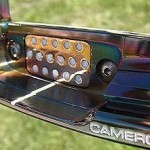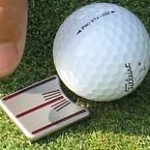The Man, The Myth, The Legend, Scotty Cameron
Scotty Cameron and his team of designers, based in Carlsbad, CA have established an impressive position in the golf world. In the world of marketing, Scotty Cameron is the gold standard. Cameron has obtained the metaphorical golden nugget, the power of perception. To many Scotty Cameron represents excellence, craftsmanship, and a dedication to creating remarkable putters. Simply put, Cameron is a cult hero. From the numerous sites frequented by his collectors to an established Scotty Cameron Museum and Gallery based in Japan many have praised and revered his vision of proper putter design principles. Whether you agree with this sentiment or not Scotty has established a reputation as a leader in the world of putter design.

It is interesting that all of this stems from the innovative yet simple concept of the 1966 design by clubmaker Karsten Solheim, the Ping Anser. 28 years later, a concept scribbled on a record cover would become the model for Scotty Cameron’s success. Cameron possessed a vision to create the finest putters in the world. In 1993, a Cameron putter found its way on to the center stage of the golf world and one of golf’s greatest achievements, the Masters. A partnership with Titleist followed and the legend was created.

Cameron has divided his attention into two distinct paths. One satisfies the general population while the other focuses on true believers, Scotty Cameron collectors. I myself have a passion for putters but, like many others, I do not limit myself to the work of Scotty Cameron alone. Spend a week or so in the inner circles of putter collectors and you’ll discover a passion that is as deep as any other in the world. Cameron is certainly not alone, although he continues to maintain a grasp on touring professionals and golfers of all abilities. Byron, Bettinardi, and TP Mills are some other names commonly discussed  in collector circles. There seems to be a perpetual battle between the common man and the God of putters, Scotty Cameron. The debate boils down to head weight, metallurgy, putter theory, the proper stroke, hand stamps versus engraving, and even paint fill schemes. I have had the opportunity and pleasure of getting to know several collectors. While connecting with collectors I have begun to understand what drives this passion. Many boast collections of 100 putters plus ranging from original, first production Ping Anser’s to the most revered Cameron creations. Many will argue over their collections and what makes them unique. Whether it be a tour model or a“garage style” handmade with its signature graffiti style there is something that draws these people together. The debate doesn’t end there and continues with the final question at hand: whether to game or not. Many of these putters
in collector circles. There seems to be a perpetual battle between the common man and the God of putters, Scotty Cameron. The debate boils down to head weight, metallurgy, putter theory, the proper stroke, hand stamps versus engraving, and even paint fill schemes. I have had the opportunity and pleasure of getting to know several collectors. While connecting with collectors I have begun to understand what drives this passion. Many boast collections of 100 putters plus ranging from original, first production Ping Anser’s to the most revered Cameron creations. Many will argue over their collections and what makes them unique. Whether it be a tour model or a“garage style” handmade with its signature graffiti style there is something that draws these people together. The debate doesn’t end there and continues with the final question at hand: whether to game or not. Many of these putters  will never touch the surface of a green, destined to remain a relic in a cherry wood rack.
will never touch the surface of a green, destined to remain a relic in a cherry wood rack.
The power of obsession does not end with carbon steel or handmade ostrich grips but continues with pieces of sewn fabric, felt, leather, and finely crafted aluminum. The accessories are the bane of the collector. Ranging from a variety of headcover designs and ball repair tools, Cameron covers another portion of the market with such creations. Once you have found that perfect 009 GSS Tour Putter, averaging a modest $2000 on eBay, you have to somehow house this work of art. Cameron, along with manufacturing partner AM&E, have paired up to create the ultimate in putter headcovers. It is common to stumble on collectors with upwards of 150 headcovers and more. Parodies on brands such as Tiffany & CO, covers dedicated to the major tournaments, and ultimately Tour Issue “Circle T” covers have established this relatively simple accessory as a staple in any collection worth its merit. Cameron’s latest release, the Cameron Ball Marker that is crafted from stainless steel, has fueled the latest Cameron craze. This tool hopes to replace the traditional United States Quarter.
of 150 headcovers and more. Parodies on brands such as Tiffany & CO, covers dedicated to the major tournaments, and ultimately Tour Issue “Circle T” covers have established this relatively simple accessory as a staple in any collection worth its merit. Cameron’s latest release, the Cameron Ball Marker that is crafted from stainless steel, has fueled the latest Cameron craze. This tool hopes to replace the traditional United States Quarter.

While collectors worldwide are foaming at the mouth over the latest release of the Damascus D-009 putter and accessories, a fifteen year old is picking up his first Cameron at a local golf shop. Many question the quality and the significance of a Scotty Cameron putter. With the hefty price tag often found on Cameron’s it is a question worth asking. Here is where this topic becomes interesting. Unlike drivers and the latest game improvement irons, putter designs have remained somewhat constant in their materials and ultimately their purpose. Fairway woods have morphed into hybrids while drivers have found new geometric shapes concentrating on achieving the highest MOI, yet putters are the anchors in our bags.
My own collection began with the exact perception that drives this debate. I was an ambitious and naive golfer who thought he could purchase his game. It all started with a trip to my local shop and a Scotty Cameron Studio Style Newport II. My perception of the Scotty Cameron image and brand drove my purchase of a $300 putter. Over time my interest in putters, and all of their intricacies, has grown from an interest into a small and modest collection. Although a simple concept, putters can become quite complex. Fitting a putter into your game requires a great deal of research and patience. Loft, lie, head weight, neck design, and the amount of toe hang are a few elements that go into a properly fit putter. Ultimately, your putter choice comes down to aspects that can’t be measured, feel and confidence.
Putting is a true mental art and much of this stems from the confidence we have in our equipment and its performance capabilities. There are arguments on both sides but ultimately the price tag of your putter will not dictate its performance. Unlike Cameron, there are several putter designers who remain well under the radar. Designers such as Tom Slighter, George Palombi, and TP Mills have built solid reputations among putter aficionados but have been unable to crack the general market. As many of us know, excellence on the green translates into lower scores, a club championship, or just beating your best friend for the first time. Whether you have the latest Scotty Cameron creation or that old putter passed down from your father, the ultimate goal remains the same, getting the ball in the hole.
So just remember one thing my friends, don’t worry about how people perceive your bag. When the birdie falls, just tap your cap and remind your playing partners it was 20 bucks at the local yard sale that just won the hole.
Dan D.













I’ve never been able to justify to myself spending so much for any single club. I also feel more confident putting with a more center-shafted putter. If I could find the putter in the last picture with that kind of shaft moved to the center of the face, then I may consider it. Spending $100 on the putter I have been using for quite a few years now took a bunch of twisting my own arm to finally pull the trigger. It was money well spent, but the best putter I ever had was a garage sale pickup that I snapped the head off in the Arizona desert (don’t ever use a putter that is attached to the shaft like the top two pictures to whack a ball out of the desert!). Granted, it may have been the best putter I ever had because I had better nerves back then!
I’ve loved my Bettinardi since I bought it, but now you have me thinking I should be out there, testing alternatives. This site is dangerous, I tell you!
Cameron 009 putters go for about $2000 – but good luck finding a GSS putter for that – GSS and 009 are mutually exclusive. GSS putters are sold under the ‘Cameron & Co’ label and go for about $4500 and up.
I am not a Cameron enthusiast or collector (I own one Cameron Bullseye and that’s it) but I thought I’d add that small correction.
Mike M
Check out the Scotty Cameron Red X2, it is just what you are asking for, a center shafted putter like the one in the last picture.
Now THAT IS what I deem an insightful position on things. What I would advise perhaps is speaking to other people actively involved in the scene and bring to day any other points of view and then update or create a new post for us to stew over. Hopefully you’ll take my advice, I’m looking forward to it! Try to cover off on some graffiti characters as well if possible, they’re very popular at the moment.